Introduction
In order to succeed as an effective human resource (HR) manager, it is necessary to receive the knowledge of theories and efficient practices and develop certain skills. The objectives stated for this set of activities are to a) understand the requirements for becoming an effective HR professional; b) demonstrate how to perform efficiently as an HR specialist, and c) demonstrate how to apply CPD techniques to work with a personal development plan. In the context of these objectives, the paper will present how to use a Profession Map, group dynamics and conflict resolution approaches, project management and problem-solving techniques, and a personal development plan.
Activity 1: The Effective HR Professional
The development of a person into a professional can be associated with the application of a Profession Map. It is important to explain how this tool can be successfully applied by HR professionals in their everyday activities. The next step is the description of activities and behaviors related to the selected professional areas in this map. Besides, it is also necessary to demonstrate how the Map components can explain the meaning of HR professionals’ activities. Finally, the evaluation of the importance of the described competencies and behaviors for developing the role of an effective and efficient HR professional should be provided.
The CIPD Profession Map and Its Application
Chartered Institute of Personnel and Development (CIPD) has developed the Profession Map for the purpose of guiding the career progress, development, and activities of HR professionals in 2013 (Figure 1; CIPD 2020). In 2018, the version of the Map was revised to present international benchmarks for the HR profession in a more efficient manner (Figure 2). The Map represents the building blocks of HR managers’ professional activities with a focus on ten professional areas, four bands, and eight behaviors that are important for HR specialists.
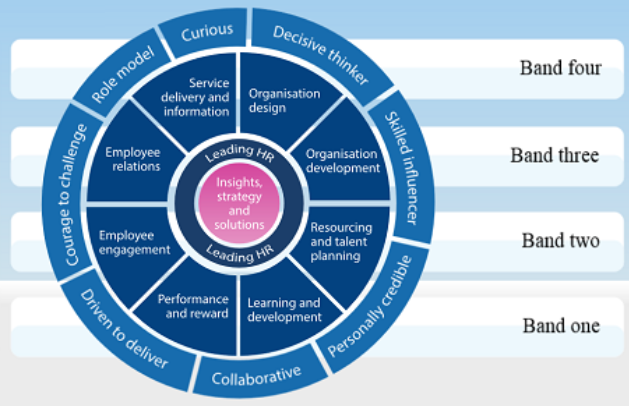
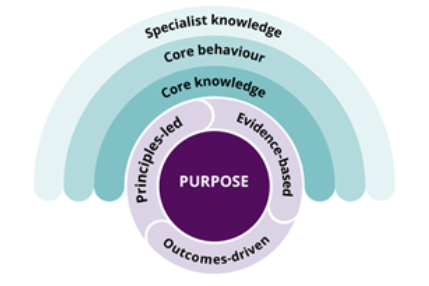
Bands are associated with different levels of practice, and at Band 1, HR professionals provide fundamental support. At Band 2, HR professionals act as advisers who address identified issues and challenges. At Band 3, HR professionals address challenges at the higher organizational level. At Band 4, HR professionals perform as leaders and develop strategies. Professional areas determine the knowledge and activities for HR managers at different levels (bands) of professional practice.
They include such cores as Insights, Strategy, and Solution and Leading HR, as well as organization design, learning, and development, organization development, performance and reward, resourcing, employee relations, employee engagement, service delivery, and information. Behaviors support HR professionals’ activities, and they are related to separate bands (CIPD 2015). They include being curious, the courage to challenge, credible, driven to deliver, collaborative, a skilled influencer, a decisive thinker, and a role model.
HR professionals and organizations use this Map in order to identify and follow standards for the HR profession. Thus, using these benchmarks, HR specialists are aware of behaviors, activities, and levels of professionalism they need to address or demonstrate (CIPD 2015). The application of this tool is important to accentuate behaviors and activities that help HR managers to develop from specialists performing basic roles to leaders responsible for developing strategies in organizations.
Knowledge, Activities, and Behaviours at Band 2
At Band 2, certain activities need to be demonstrated by HR specialists in such a professional area as Organisation Design. An example of such activities is the regular analysis of processes, systems, and structures in organizational design to achieve strategic goals and compare them with stated benchmarks. Such an analysis must be complex and multidimensional. The theory of organizational design and approaches to organizational development have changed over time. While in the beginning, the focus was mainly on the analysis of the structures of organizations, later the necessity of considering people’s behaviors, which is rather a dynamic (processual) than a static factor, emerged. At present, these approaches are closely intermingled in light of understanding that the change in one component causes modifications in others, affecting the whole system.
Besides, it has to be emphasized that the regularity of the analysis enables the monitoring and evaluation of the relation of inputs, outputs, and results, and the ability to modify or change the strategy if the level of efficiency in this field becomes lower. The importance of the analysis of results is evident as it gives the vision of the current situation considering organizational goals in general.
The key behavior at this level associated with the activity is a curiosity to conduct the most detailed analysis (CIPD 2015). Being curious in a professional sense means the commitment to constant development and gaining knowledge. As organizational design is a rapidly changing area, the requirement of openness for innovations, driven by curiosity, is of utmost importance. The required knowledge is how to access and apply organization design tools and techniques to realize certain design decisions. In other words, the vision of the general goals must be supplemented by the concrete knowledge of the instruments of its achievement; the absence of those would prevent the decision from being implemented.
In the professional area titled Resource and Talent Planning, the main activity at Band 2 is the identification of skills required for talents in an organization at the current and future levels of development, and the assessment of resources’ capabilities. In this context, the associated behavior is being a decisive thinker to determine what talents need to be attracted at the current stage of an organization’s progress to contribute to its success. The activity and the associated behavior are important, considering that only in the case of the right choice of talents organisations can achieve high performance and continuous development.
The knowledge required by HR specialists at this stage is the realization of a recruitment plan according to the set goals and deadlines (CIPD 2015). In case of not accomplishing this task, the organization will experience a lack of resources that will result in losing its effectiveness. Thus, the examples of knowledge, activities, and behaviors in two selected professional areas are correlated with the second level of HR specialists’ career progress – Band 2.
The Use of the CIPD Profession Map
All the components of the CIPD Profession Map are used in organizations as a complex or separately to specify requirements, benchmarks, or standards for HR specialists to follow at different stages of their professional growth. HR professionals orient towards the Map when they plan their career and understand what knowledge and skills to develop in order to come through all four bands. Furthermore, the Map is also supported by the CIPD resources in order to explain in detail what activities are associated with each professional area (CIPD 2020). These resources help HR professionals as guidelines to pay attention to and follow in order to achieve success in their daily activities. Thus, actions expected for different behaviors are also listed in these support materials. As a result, using the Map, it is possible to develop the professional competence to perform the job roles of an HR manager in the most efficient manner through understanding what to do, how to do, and what to know.
Activity 2: Group Dynamics & Conflict Resolution
For the purpose of explaining group dynamics, it is necessary to describe particular factors that can affect group dynamics within the framework of a certain theory/model. Furthermore, the example of applying this theory to the process of team development will also be provided in this section. Additionally, the issue of conflict resolution will be discussed with reference to two examples of how conflict resolution methods can be applied in the most effective way.
The Model and Factors That Influence Group Dynamics
The theory selected for explaining group dynamics in teams is Bruce Tuckman’s model that is based on five stages: forming, storming, norming, performing, and adjourning. These stages are overcome by all teams in the process of developing their units to demonstrate progress and effective performance at the final stages (Moraru, Dub & Sroka 2019). At the stage of Forming, team members are usually under pressure of such factors as their feelings that include uncertainty, dissatisfaction, and confusion among others. The problem is that, at the stage of forming a team, individuals do not know each other and their roles and tasks, have no identified leaders, and resist a situation. The second stage is Storming which is connected with the impact of factors related to their process of work and feelings: disagreement, conflicts, the fight for power, and dysfunction. At this stage, it is rather challenging for team members to accept leadership and develop a single approach to reaching goals.
The third stage is Norming, and the factors that can be influential during this period are the specifics of a working process, members’ flexibility, and their readiness to cooperate. The reason is that individuals begin to become aware of individual differences and strengths of each other and develop group cohesion. As a result, the process of performing certain duties and responsibilities becomes stable and regulated. The next stage is Performing that is associated with such factors as feelings and the content of work. When reaching this stage, team members have cohesiveness in their group, and they can effectively cooperate to achieve goals (Moraru, Dub & Sroka 2019). The final stage is Adjourning, at which a group becomes disorganized because of a range of factors, including changes in an organization, economic factors, the project completion, and others.
It is possible to apply this model to the example of team development in a certain selected organization. The team that was organized to work on developing a corporate website has overcome four stages determined by Tuckman (without Adjourning). At the stage of Forming, the team suffered from communication and role identity problems, and it was important for an HR professional to set a clear goal for the team and provide required training to complete tasks. At the Storming stage, it was necessary to determine job responsibilities for each participant and contribute to a positive atmosphere in the team. At the stage of Norming, it was critical to support team members’ flexibility in their cooperation and decision-making to promote collaborative work. At the final stage of performing, much attention should be paid to promoting group cohesion.
Two Examples of Conflict Resolution Models
The conflict that occurred in the selected organization was associated with one recruiter’s unwillingness to cooperate with other recruiters as part of the HR management team in order to realize HR goals. The problem was that the discussed recruiter did not accept the leadership of a team leader and wanted to be promoted because of the team leader’s weak performance. There are two key conflict resolution models that can be applied to address this situation. The first model is the Thomas-Kilmann model, according to which the conflict resolution depends on such factors as assertiveness and cooperativeness (Figure 3).
Referring to the extent of these qualities in an individual’s actions, the conflict resolution approach may be competing (high assertiveness and low cooperativeness), collaborating (high assertiveness and high cooperativeness), compromising (middle assertiveness and middle cooperativeness), avoiding (low assertiveness and low cooperativeness), and accommodating (low assertiveness and high cooperativeness) (Cordell 2018). For the discussed conflict, compromising is the most effective strategy to guarantee that the team goal will be addressed. As both parties have different commitment, assertiveness, flexibility, and cooperativeness levels, an HR manager should propose a decision that will partially address all needs.
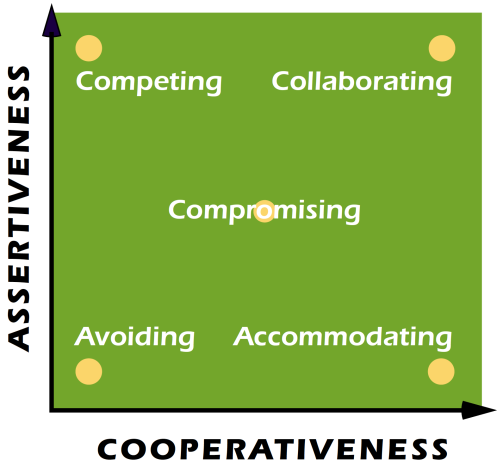
The second model to discuss is Fisher and Ury’s Model that is focused on the principles of negotiation. In this model, there are four elements of the declared principled negotiation: people, interests, criteria, and options. The goal, in this case, is to find a win-win solution while referring to the involved parties’ expectations and interests with reference to the available options and set criteria for success until formulating the mutual interest (Figure 4). In the discussed conflict, it is necessary to start with determining the interests of the involved recruiters to explain their positions and identifying criteria for an effective solution (Cordell 2018).
The next step is the formulation of options and the selection of a win-win path to satisfy the expectations of both parties. In the mentioned case, it may be assumed that the current leader is supposed to imply an authoritarian model of leadership while, due to his personal qualities, he would be more effective in following the democratic model or laissez-faire. At the same time, the recruiter that demonstrates the initiative might be more effective in acquiring a higher level of leadership.
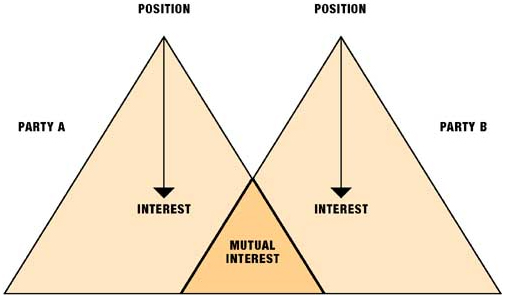
Activity Three: Project Management
One of the projects developed in the HR department of the selected organization was aimed at designing a 10-day training program for the probation period involving new employees. It was necessary to determine the areas of knowledge and skills to obtain, develop, and train during the probation period in order for a new employee to become part of the team. The project task also included the development of a schedule and activities to perform.
Application of Project Management/Planning Techniques
To perform the assigned tasks in the context of the project development, it was necessary to apply such two project management and planning tools as a work breakdown structure (WBS) and a Gantt chart. To organize all the goals, tasks, and activities discussed by the team leader in one system to follow and focus on project deliverables and outcomes, it was necessary to design a WBS (Heagney 2016). This WBS was created for the team to visually represent the whole scope of the work and tasks assigned to different team members. Figure 5 provides the fragment of the draft for the WBS used in the project.
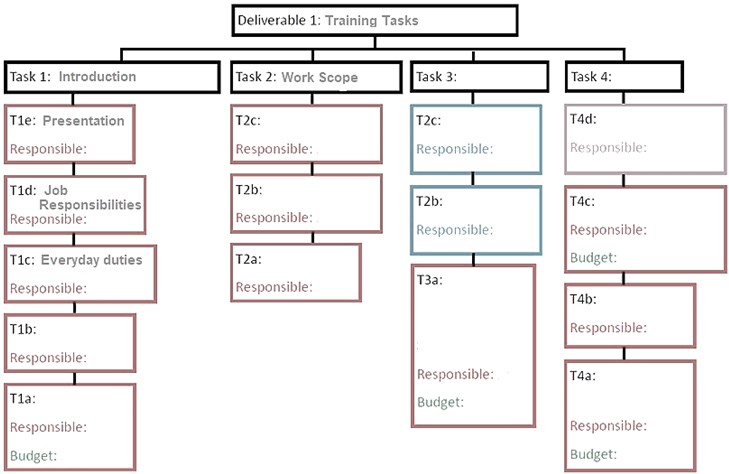
A Gantt chart was applied during the project in order to support the project development and realization with the help of visually representing the work schedule for the training project, important dates, and deadlines. This chart was used to support the WBS and help to plan activities and effectively coordinate the work of assigned responsible people according to the schedule and set deadlines (Heagney 2016). The detailed Gantt chart included the progress of work and deadlines for tasks reflected in the WBS for responsible persons, as it is represented in the draft variant in Figure 6 (task specifics are hidden).
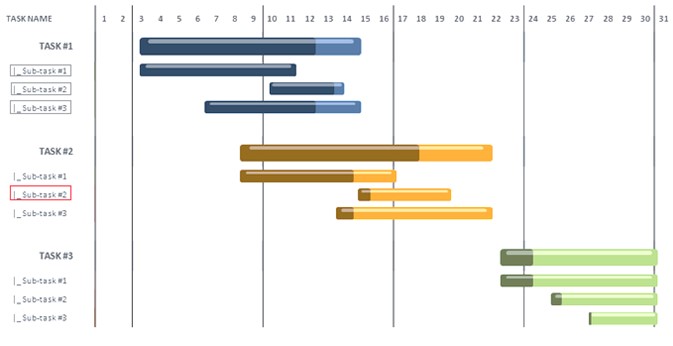
The two program management techniques applied in the described case are best suited for effective performance, as they ensure a clear structure of the educational program. Breaking up the syllabus into tasks consisting of a number of sub-tasks would make the process of obtaining the knowledge easier. Further, the Gantt chart would be used as a tool for monitoring the process of accomplishing each task and sub-task.
Application of the Problem Solving Technique
The time constraint was the key problem in the project realization process, and to address it, one applied the GROW (Goal-Reality-Obstacles-Options-Way Forward) model. First, it was necessary to determine the goal for the project and analyze the current reality. At this step, it was identified which primary criteria would be applied to identify the accomplishment of the goal and which of them are secondary and would be negotiated. The next step was observing the challenges and problems that can provoke time constraints.
Obstacles causing the impossibility to address deadlines were analyzed, and options were developed to minimize these problems and proceed with the project development (Heagney 2016). It was possible to focus on decreasing the scope of work for some tasks, which had been identified as secondary for the goal accomplishment. At the same time, it was offered to reconsider schedules for some specialists in order to guarantee they can perform more activities per day. Thus, at the final stage, specific action steps were taken to respond to the challenge and overcome the time limit problem without compromising the goal and associated deadlines.
Application of Influencing, Persuading and Negotiating
The experience of working on the project of developing training for new staff was challenging and helpful as it was possible to develop skills in influencing, persuading, and negotiating with co-workers. Skills in influencing were used when it was necessary to lead a small part of the team in order to develop an effective WBS. As these team members also had their specific tasks, one should have influenced them to attract them to participate in this project and follow the supervisor’s instructions; this task was realized successfully (Cordell 2018). Persuasion skills were demonstrated when it was necessary to convince team leaders to adopt the project budget estimation with reference to the developed schedule because these tasks were not categorized as priorities for managers (Heagney 2016). The success in accomplishing the tasks that required both influencing and persuasion was provided, among all, by using the element of Neuro-Linguistic Programming (NLP).
This approach, developed by Richard Bandler and John Grinder implies the scanning of people’s subliminal language structure and adjusting the strategy of speech and action in accordance with it. Negotiation skills were applied when it was necessary to discuss the assigned tasks; in this case, a win-win model was used. The focus on cooperating helped to achieve win-win solutions to the problems, and the position was based on research, evidence, and arguments.
Activity 4: CPD
Self-Assessment of HR Professional Capabilities
My CDP Map is an efficient tool not only for self-assessment but also for identifying the areas for improvement and recording progress in developing knowledge and skills in HR. The conducted assessment demonstrates that the current level of knowledge and skills can be associated with Band 2 activities in the majority of professional areas as it is necessary to pay more attention to analysis, problem-solving, and leadership (Figure 7). The current level of progress directly meets current goals in the professional field, and the proposed CPD options effectively meet present needs. The self-assessment is effective to show that more work and achievement are required in such areas as Insights, Strategy, and Solution and Leading HR as the most challenging areas. My achievements in the Learning and Development area are rather satisfactory.
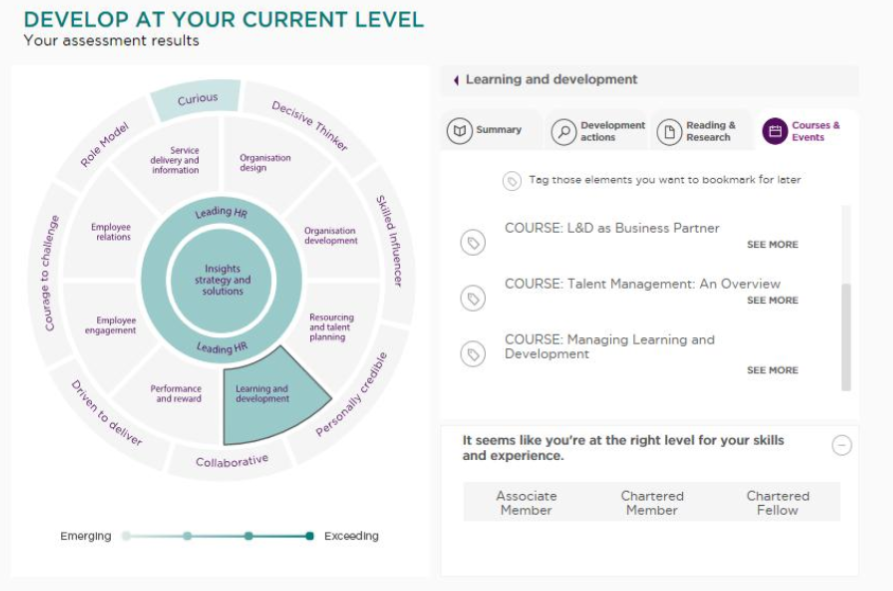
Professional Development Plan (PDP)
The following PDP includes the objectives and resources to achieve them in association with the improvement areas identified during the self-assessment with the help of My CDP Map. Table 1 presents the PDP with the three listed objectives, required actions, resources, success criteria, and targets. The period for reaching the set goals is also included in the table.
The improvement of the skills in employee engagement to influence group dynamics has been set as the initial objective. In HR professionals’ performance, this is the skill of utmost importance; at the same time, it requires time and continuous feedback to be developed. The reason for it is its dependence not only on skills that might be formally trained but also on particular personal qualities. As a consequence, the second objective requires, apart from self-assessment, the feedback of the tutor and peers. Finally, personal feedback is necessary for a clear awareness of the drawbacks to being further eliminated.
These objectives are essential in light of my long-term goal, which is to succeed in performing HR professional duties in multinational organizations successfully. In such environments, there is always a risk that different cultural backgrounds of employees may cause differences in understanding the global goals of the organization, as well as conflicts within the collective. These factors can result in lower employees engagement and the level of the organization’s performance. In such circumstances, the task of an HR specialist is to be knowledgeable, psychologically sensitive, and, which is the main factor, to be able to influence people.
Table 1: Professional Development Plan.
Conclusion
Four specific activities have been completed to demonstrate the HR professional practice competencies. The report has presented the description and analysis of the CIPD Profession Map and its application in the HR professional area. The information on approaches to influence group dynamics and resolve conflicts in teams is also provided in the report. A separate section is related to discussing the project management techniques and tools that were applied when working on the real-life project on developing training for new staff in a certain organization. Self-assessment results and the PDP have been discussed in the final section of the report.
Reference List
CIPD. 2015. The CIPD profession map: our professional standards. Web.
CIPD. 2020. The CIPD profession map. Web.
Cordell, A. 2018. The negotiation handbook, Routledge, London.
Heagney, J. 2016. Fundamentals of project management, Amacom, London.
Moraru, RI, Dub, T & Sroka, M. 2019. ‘Group development process in management of work teams’, Quality-Access to Success, vol. 20, pp. 1-12.
The Fisher and Ury’s Model 2016. Web.
The Thomas-Kilmann Model 2018. Web.
Appendix A. (Survey Result)
Employee engagement
When you work in Employee Engagement you’re working to strengthen the connection that all employees feel with their work, their colleagues and with the organization, increasing the level of contribution they make by improving the fulfilment they get from their work. At your level you typically need to help the organization research and identify the key drivers for employee engagement and support the implementation of engagement plans at a local level. You’ll work with managers and their staff to improve engagement by enabling employees to increase their contribution to the organization. When you work in Employee Engagement you’re working to strengthen the connection that all employees feel with their work, their colleagues and with the organization, increasing the level of contribution they make by improving the fulfilment they get from their work. At your level you typically need to help the organization research and identify the key drivers for employee engagement and support the implementation of engagement plans at a local level. You’ll work with managers and their staff to improve engagement by enabling employees to increase their contribution to the organization.
How prepared am I?
What you’ve told us indicates that your knowledge and skills in this area are meeting expectations. This would be typical of someone who has strong experience in HR and Employee Engagement at this level.
Below, we show you the areas where you’re particularly strong, areas where you’re competent and areas where you have skill and knowledge gaps. If you’re keen to increase your knowledge and improve your skills in Employee Engagement, you should consider the courses, reading materials and practical development actions that we’ve recommended for
you. These recommendations reflect your individual strengths and development areas based on what you’ve told us in your assessment. Your score suggests you may be ready to assess yourself against the next level up, or in a different area of HR. To do this, return to the home screen to take a different assessment.
What’s it like working within Employee Engagement at a more senior level?
In order to be able to work at the next level up within Employee Engagement, you typically need to focus on the link between employee engagement and the organization’s overall performance. You’ll work with managers to make sure employees and other
Stakeholders understand and respect the organization’s values and behaviors. You’ll also make sure that key messages about the employer brand are reflected at all stages of the employee lifecycle.
What are my strengths and gaps for my current level?
- My strengths:
- Monitoring and measuring key business performance metrics and trends relating to engagement.
- The factors which influence people’s behavior at work.
- Where I am competent:
- Designing and conducting employee research and surveys to build understanding of engagement in the organization.
- Challenging managers to be open to feedback and to use engagement data to inform their decision making.
- Implementing practical and timely engagement initiatives with teams.
- Managing processes for employees to raise concerns about values and behaviors (eg, feedback schemes)
- Different research methods My Gaps.
- Developing practical initiatives to improve the engagement of employees.
